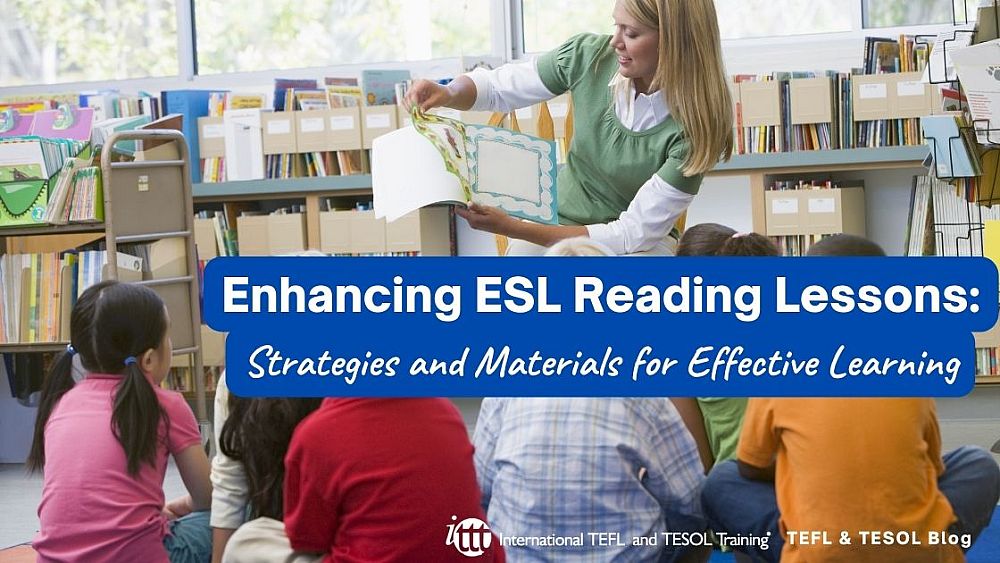Enhancing ESL Reading Lessons: Strategies and Materials for Effective Learning

Reading comprehension is a crucial skill for ESL (English as a Second Language) students to develop. As teachers, it is essential to select appropriate resources and employ effective techniques to maximize the benefits of reading activities in the classroom. In this blog post, we will explore various types of reading materials, discuss strategies to improve reading comprehension skills, and highlight the importance of integrating discussions into the learning process.
Table of Contents
Strategies for Improving Reading Comprehension Skills
Are you ready to teach English as a foreign language?
Check out what our course grads say in our many video testimonials!
Types of Reading Materials
Before planning reading lessons, it is highly recommended for teachers to read Tracy Linderholm's article, "Reading for a Purpose." The article provides valuable insights into utilizing reading materials effectively and can serve as a useful resource for educators. Additionally, when selecting reading materials, teachers often classify them into two categories: authentic and non-authentic.
Authentic Materials:
Authentic materials refer to resources that were not specifically designed for language learning but are commonly found in real-world contexts. Examples of authentic reading materials include books, magazines, menus, travel brochures, and more. By incorporating authentic materials into the classroom, students gain exposure to real-life language usage and cultural aspects, enhancing their language skills and cultural understanding.
Non-Authentic Materials:
Non-authentic materials, on the other hand, are specifically created for language learning purposes. These materials are often graded according to the students' proficiency level and incorporate targeted language features. Non-authentic reading materials can be particularly suitable for lower-level English classes, including Starter classes. As students progress to higher levels, integrating authentic materials into the classroom can provide a more comprehensive language experience.
Strategies for Improving Reading Comprehension Skills
To ensure effective reading practice, teachers can employ various strategies that engage students and foster comprehension. Here are some techniques to enhance ESL students' reading comprehension:
Skimming and Scanning:
Skimming and scanning are valuable reading techniques that encourage students to quickly obtain a general overview or search for specific information within a text. Skimming involves looking through a passage to grasp its main idea or gist. Scanning, on the other hand, focuses on finding specific details or answers to pre-determined questions. Teachers can assign skimming or scanning tasks, such as summarizing an article's topic or identifying specific facts within a given time frame.
Summarizing:
Summarizing is a higher-level skill that requires students to extract the main points from a text. Initially, teachers can introduce this skill using non-authentic materials that are graded to suit the students' proficiency level. Summarizing helps students practice synthesizing information and identifying key ideas, promoting a deeper understanding of the text.
Predicting:
Predicting encourages students to anticipate what will happen next in a reading passage. This activity integrates multiple skills, including reading, listening, and writing. While predicting is best suited for higher-level groups, it can be adapted for various proficiency levels. Students can use their comprehension skills and knowledge of verb tenses to make logical predictions, stimulating critical thinking and reinforcing their understanding of the text.
Discussing:
Integrating discussions into reading lessons helps students develop their oral communication skills and enhances their comprehension abilities. After a reading session, teachers can facilitate a class discussion centered around questions related to the reading passage. These questions should specifically target the students' understanding of the material. Assigning the reading as an external activity before the discussion session allows students to prepare their thoughts and actively participate in the classroom conversation.
Conclusion
Effective ESL reading lessons require careful selection of materials and the application of appropriate strategies. By incorporating both authentic and non-authentic materials into the classroom, teachers can provide a well-rounded language learning experience for students. Additionally, utilizing techniques such as skimming, scanning, summarizing, predicting, and discussing enhances students' reading comprehension skills and fosters engagement and critical thinking. As educators, it is essential to stay informed and continuously explore new resources and methodologies to create dynamic and effective reading lessons for ESL learners.
Are you ready to teach English as a foreign language?
Apply now & get certified to teach english abroad!
Speak with an ITTT advisor today to put together your personal plan for teaching English abroad!
Send us an email or call us toll-free at 1-800-490-0531 to speak with an ITTT advisor today.
Related Articles:
- Top 10 Cities in Europe with the Highest Demand for English Language Teachers
- 5 Reasons To Take A TEFL Course Right Now - Even If You Are Not Leaving Yet | ITTT | TEFL Blog
- All the Documents You Will Need to Teach English Abroad
- The Impact of Positive Motivation on an ESL Classroom
- You're Never Too Old to Change Your Life and Do a TEFL Course | ITTT | TEFL Blog
- Getting Student Placement Right - The Best Desk Arrangements for EFL Students



